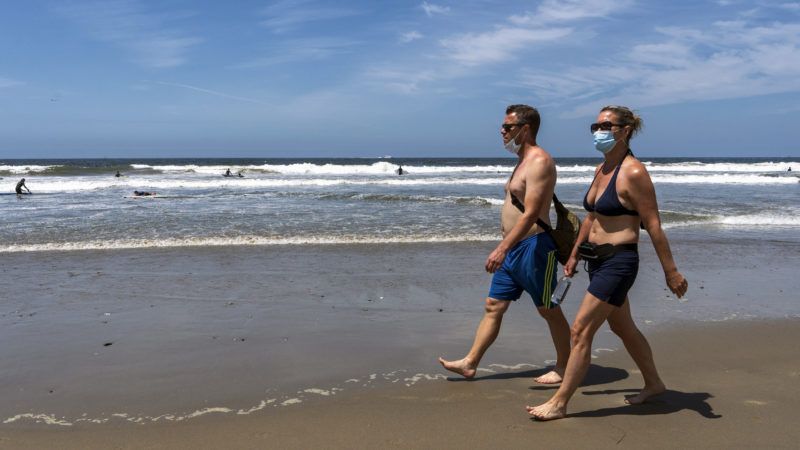California's COVID-19 Shutdown Was Driven by Science. Until It Suddenly Wasn't.
It's great that Gov. Gavin Newsom is finally looking at costs and benefits. But don't kid yourself. None of it has anything to do with "science."

In response to Californians who were protesting his lockdown orders, Gov. Gavin Newsom in April politely encouraged them to follow social-distancing practices while protesting and assured all Californians that his COVID-19 responses would not be driven by public opinion or other similarly low-brow concerns.
"We are going to do the right thing, not judge by politics, not judge by protests, but by science," the governor said.
As I noted recently, "science" isn't a black-and-white, Ten Commandments sort of thing. It is a method for evaluating the best-known data. It shouldn't be used as a mantra—or a cudgel to beat opponents into submission. It changes. Scientific forecasts are speculative and often wrong. Lawmakers have the responsibility to weigh non-scientific concerns, including those involving our liberties, and not just blindly follow what select scientists say.
Nevertheless, we all assume the governor was saying that he was following the best scientifically available information to determine when he—through his largely unchecked emergency executive powers—would let Californians reopen their businesses, leave their homes, go back to work and head to the beaches and parks again. That sounds perfectly reasonable, but it's interesting how rapidly the governor's "science" has changed.
Around a week ago, Newsom's "science" had called for a little loosening in the rules, but for a continuation of the stay-at-home orders. He had allowed some counties to petition for a quicker reopening, but imposed pages of tough restrictions on them. He sent regulators to oversee Yuba and Sutter counties and threatened to yank their aid after they defied the governor's orders. His "science" was clear: The lockdowns must continue.
Then, without much notice, the governor last week announced a much-broader reopening, which seemed to take most Californians by surprise. The governor declared that he was giving local governments the go-ahead to move quickly based on their particular understanding of their own regional conditions. This includes a likely reopening of shopping malls and dine-in service at restaurants.
A KPCW reporter asked Newsom how he could allow further openings as the number of COVID-19 cases increases by thousands daily. "We never experienced the peaks that many other parts of the country experienced. And we're seeing not only stability, but we're seeing a decline over a two-week extended period of hospitalizations and number of patients in ICUs," the governor said.
The governor also said his new rules are based on "data" showing that the state has enough hospital space and protective gear. Of course, such information has been pretty obvious for weeks. In reality, the science didn't change as much as the standard by which the state evaluates the science. Previously, the governor forbade counties from expanding any reopening unless there had been no deaths there from COVID-19 over a two-week period.
Now, as the Los Angeles Times reported, "The new standard removes the death rate requirement and replaces it with a more generous threshold based on rates of newly confirmed cases. Counties will be able to move toward a more expansive reopening if they can show fewer than 25 coronavirus cases per 100,000 residents in the last 14 days—a standard that was originally 1 new case per 10,000 residents."
Sure, California has made progress in dealing with COVID-19 infections, but there have been no seismic shifts on that front. It's like the New Math, which focused students' attention on alternative math concepts. Now we can also embrace the New Science.
Obviously, there were no substantive changes in the medical science, but there were serious changes in two other important fields: economic science and political science. The governor knows that the Trump administration is likely to give California and four other Western states the $1 trillion bailout they have requested at half past never.
Newsom recently announced that California has gone from a surplus to a $54 billion deficit—and has burned through its rainy-day fund. Union officials are upset about the proposed 10-percent public-employee salary cuts. If the state's economy doesn't get started soon, then Democrats will have to give up their big-spending dreams and the pension funds could start circling the drain.
The shutdowns have created an enormous economic problem, the extent of which might take months to become fully evident. Wouldn't you love to be a fly on the wall in any conversation between Newsom and California Public Employees' Retirement System (CalPERS) officials?
Politically, the natives are getting restless. Rural counties are in outright defiance. Even residents of urban areas are largely ignoring the restrictions. As longtime Capitol columnist George Skelton recently noted, Newsom has "barely been staying one step ahead of rural rebels who have been challenging his control and testing him" and "has wisely relented."
That's exactly right. This is excellent news, by the way. It shows that the governor is finally looking at costs and benefits. But don't kid yourself. None of it has anything to do with "science."
This column was first published in the Orange County Register.


Show Comments (113)